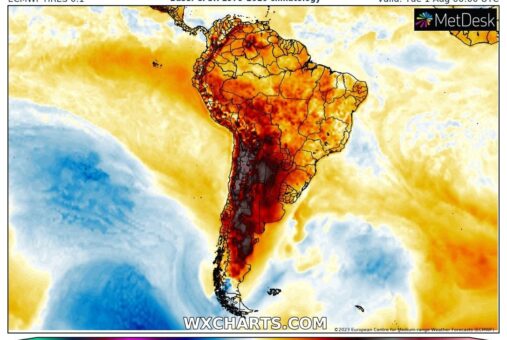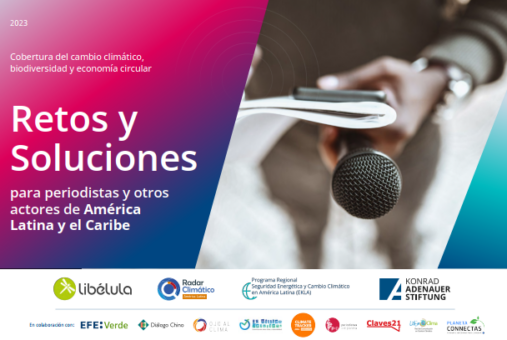Last winter in South America saw scorching temperatures that were extremely atypical for the season, further proof of the urgent need for measures against climate change. However, less than two months after the hottest day ever recorded on the planet (July 6), a new study claims that coverage of climate issues in Latin America has much room for improvement.
The survey "Coverage of climate change, biodiversity and the circular economy: challenges and solutions for journalists and other actors in Latin America and the Caribbean" found that almost half of the region's journalists believe that environmental and climate issues should be present in 30% of the news published by the press, compared to the current 2%. The 15-fold difference makes clear the difference between the magnitude of the crisis and its current representation in media.
Launched on Sept. 29, the survey was conducted by the Latin American climate platforms Libélula and ConexiónCOP, in collaboration with the Konrad Adenauer Foundation. The work involved surveys of journalists in Argentina, Bolivia, Brazil, Chile, Colombia, Costa Rica, El Salvador, Ecuador, Guatemala, Honduras, Mexico, Nicaragua, Panama, Peru, Uruguay, and Venezuela, as well as the United States and Spain.

Climate anomaly: temperatures of up to 38°C in the Andes in the midst of winter. Red and black zones show the most affected areas (Image: Wxchart.com - Metdesk)
Its main conclusion points to "the urgent need for the media to increase coverage of climate change, biodiversity and the circular economy to 30% of the total news in the region's media," according to approximately 50% of the professionals consulted, as stated in the press release.
The study used three main methods. First, it carried out a quantitative and qualitative analysis of news stories on climate change in Latin America and the Caribbean over six years, from 2017 to 2022. In addition, a survey was carried out involving more than 130 journalists from 18 Latin American and Caribbean countries. Finally, in-depth interviews were conducted with editors and former editors of news outlets with extensive environmental experience.
Combining these three methods, the study came up with eight main findings. In addition to the need to increase coverage, it found that, despite the aforementioned insufficient coverage, 64% of respondents believe the public is interested in environmental issues.
According to the survey, this perception is corroborated by a 2022 study by the Reuters Institute and Oxford University, which revealed a 42% to 52% interest in news about climate change in Latin America among the public, one of the highest rates globally.
The new survey also found that, in the perception of journalists, over the last decade there has been an improvement in coverage of topics such as climate change, biodiversity and the circular economy – that is, an economic process that prioritizes balance between the economic system, society, and the environment, in which all materials are returned to the production cycle through reuse, reduction, and recycling. This progress is mainly attributed to growing public interest, access to specialized sources and the inherent relevance of these topics.
Another important finding concerns the sources of information used in climate coverage. Journalists mostly rely on international sources — especially news agencies and international organizations — to cover climate change, biodiversity and the circular economy.
This dependence, according to the study, can limit the regional and local perspective of the news. The document points to the Climate Tracker database as an alternative for finding local sources.
"While UN organizations are relevant for information to spread globally, it is important to also work with information from local sources. For this, it is crucial to identify and build databases of local sources, and to recognize the contributions of universities and research centers in these countries," it says.
The survey also found that news outlets in the region do not have the necessary resources to cover environmental issues in a frequent, nuanced and in-depth way. Only 19% of the journalists consulted believe the editorial line of media outlets is conducive to covering the climate.
Many of the journalists consulted (87%) see journalism as a means of promoting public policies related to climate, biodiversity and the circular economy. Reporting on the opportunities and impacts of climate change is seen as a way of achieving this goal. "It is possible and fundamental to massify and bring environmental issues to the public agenda, and the press is an ally for this," according to the study.
An interesting finding is that only 22% of journalists believe they are doing their utmost to protect natural resources. However, 77% recognize the importance of contributing through their reporting to environmental issues becoming a priority in societies.
To overcome these shortcomings and improve the quality of coverage, the study proposes the adoption of three measures.
The first is to "bet on the transformation of journalism." According to the study, artificial intelligence "can help journalists process significant amounts of data, perform complex analyses and generate personalized content. AI can be useful for covering these topics, which require an in-depth understanding of science and technology."

Cover of the report 'Coverage of climate change, biodiversity and the circular economy: challenges and solutions for journalists and other actors in Latin America and the Caribbean
Multimedia journalism, meanwhile, "allows journalists to tell stories in a more immersive and interactive way. This can help readers better understand environmental problems and take action to solve them," according to the study.
Secondly, the study recommends "rigorously investigating and presenting science-backed facts to counteract disinformation." In this sense, covering the latest scientific findings on climate change and biodiversity, interviewing experts and fact-checking are useful for reducing disinformation.
Finally, the third recommendation is to "relate this global problem to our local reality." According to the study, "the region's media should balance coverage of negative impacts with local stories about solutions and opportunities offered by climate change mitigation and adaptation, biodiversity restoration and the circular economy."
In an online event to launch the report, Julia Sandner, director of the Konrad Adenauer Foundation's Regional Energy Security and Climate Change Program in Latin America, said that "the aim was not only to diagnose the current situation, but also to propose solutions and reflect on how environmental journalism can be an agent of change."
Pilar Celi Frías, editor of Radar Climático and Libélula, who conducted the survey, made a gloomy diagnosis.
"We realized that the media really don't reflect the magnitude of the crisis we are facing as humans," she said.
(Photo: Bachelot Pierre J -CC BY-SA 3.0)